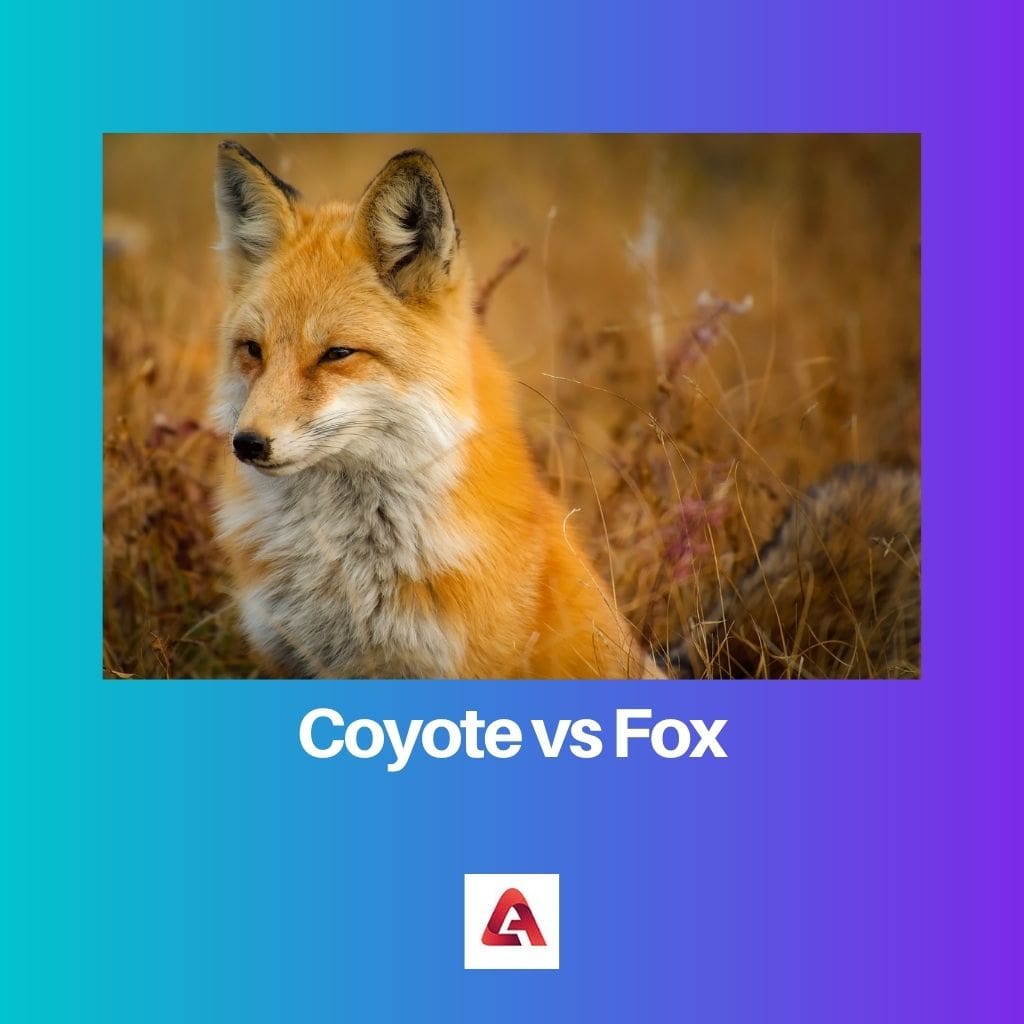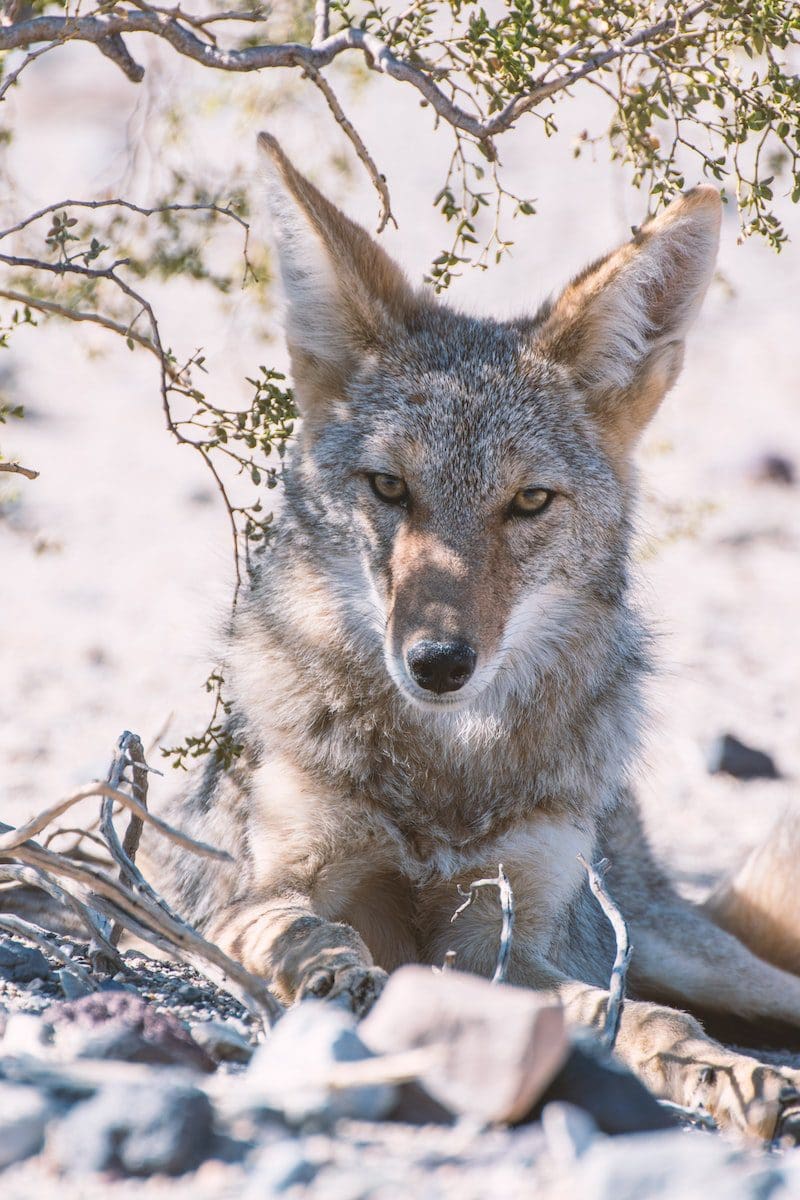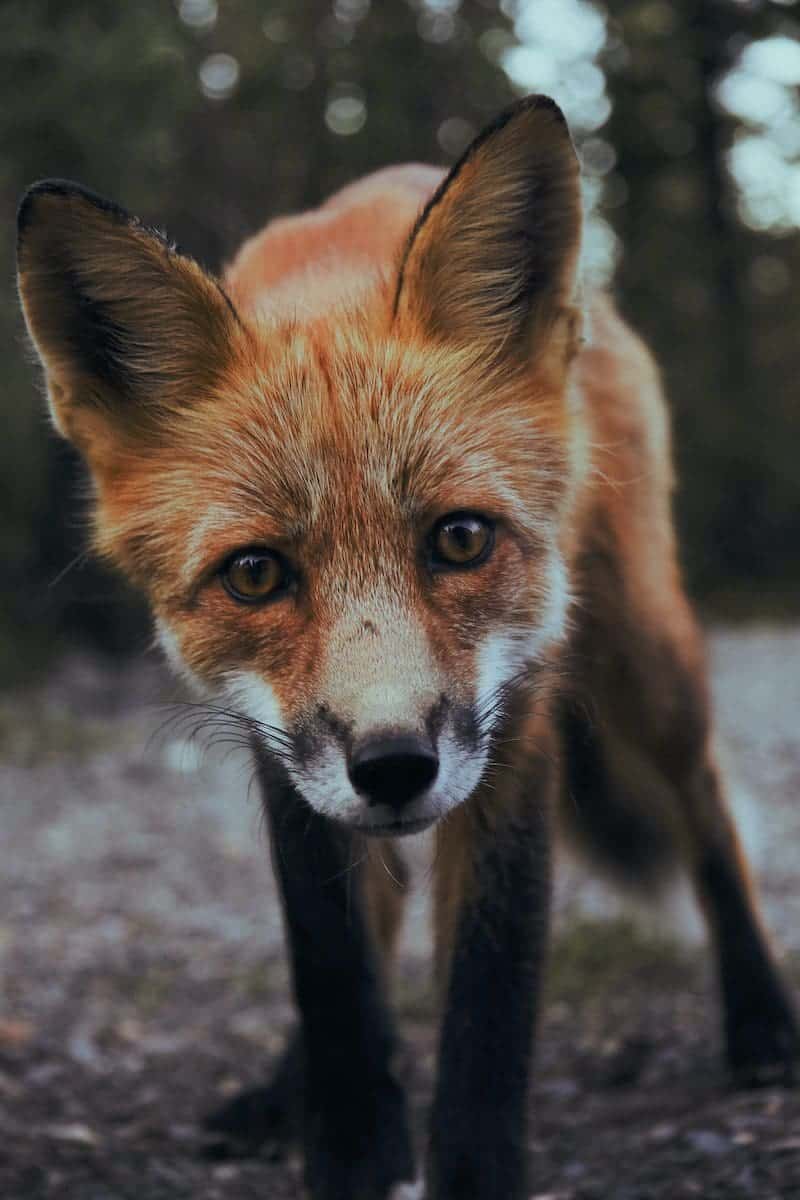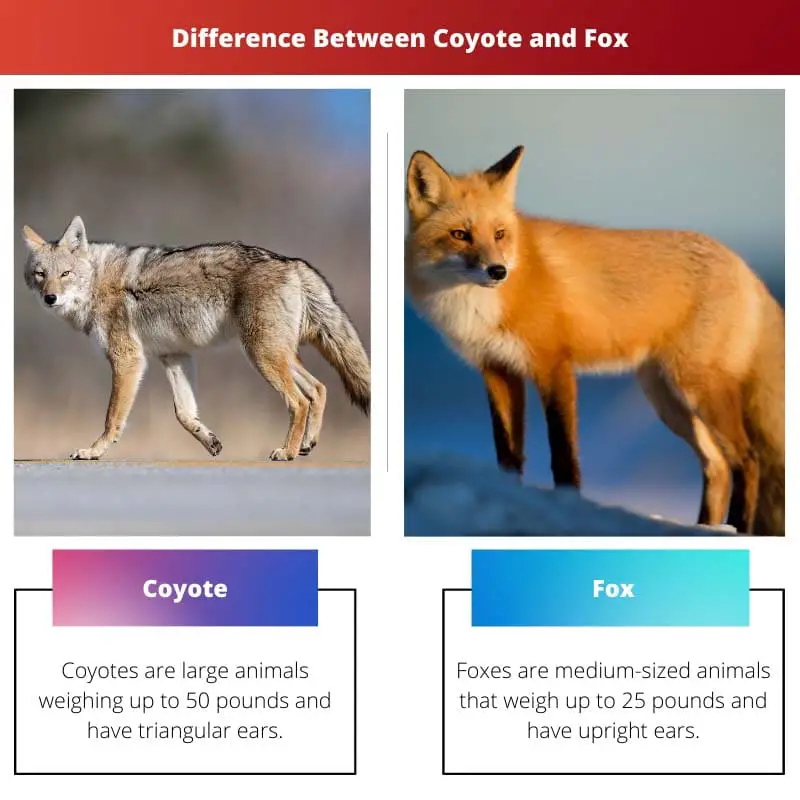Coyotes and Foxes are animals that belong to the same family, Canidae. Both of them are similar as far as their physical appearance is considered.
Coyotes are wild animals that are primarily found in Northern America. It has the advantage of adapting anywhere.
Foxes are omnivorous animals found on six continents.
Key Takeaways
- Coyotes are medium-sized canids native to North America, known for their adaptability, intelligence, and distinctive vocalizations.
- Foxes are smaller canids found in various parts of the world, with species like the red fox having a widespread distribution and a reputation for cleverness.
- Both coyotes and foxes are important members of their ecosystems, but they differ in size, appearance, and behavior.
Coyote vs Fox
Coyotes are wild canines that are uniform in appearance found mainly in North America. They are larger, muscular and have a bushy tail. They occur in packs. Foxes are within the genus Vulpes and exist in various body shapes, sizes and color patterns and their tails are not bushy. They mostly live in solitary.

Coyotes are animals found in North America and are now expanding to parts of Mexico. They are similar to foxes because of their structure and appearance.
They are smaller than both the eastern and red wolf. It is also called the American Jackal.
They are found abundantly, and hence no threat of extinction is found.
Foxes are animals that are found both in the wild and in the countryside. Twelve species are identified as true foxes.
Red foxes are the most commonly found species. The animal is a predator and is very cunning while catching its prey.
The animal was found many years ago and hence is a part of folklore worldwide.
Comparison Table
| Parameters of Comparison | Coyotes | Foxes |
|---|---|---|
| Appearance | Coyotes are large animals weighing up to 50 pounds and have triangular ears. | Foxes are medium-sized animals that weigh up to 25 pounds and have upright ears. |
| Diet | Coyotes can kill up to medium-sized animals like deer and feed on snakes. | Foxes are themselves small and hence eat rabbits and other small animals. |
| Social Appearance | Coyotes are found individually. | Foxes are found in packs. |
| Period of appearance | Coyotes like to hunt in the daylight. They roam around the jungle throughout the day. | Foxes hunt at night. They are found sleeping in the daytime. |
| Gestation period | They have a gestation period of 50 days. | They have a gestation period of 60 days. |
What is Coyote?
Coyotes are giant animals that are found in the Northern parts of America. They are similar to animals in the case of adaptation.
The environment is not a problem for them. They weigh about 50 pounds, and hence they have a huge appetite.
They feed on various animals ranging from deer to snakes and other reptiles.
Coyotes and Foxes are not found together. This is because of the diet they follow.
Coyotes weigh twice that of foxes; hence coyotes can also feed upon foxes. They also eat small animals like rabbits and birds like ducks.
So when both of them live together, there would be a shortage of food which is harmful to both of them.
There are lots of species of coyotes that are found living. So there is no risk of them being endangered.
The International Union for Conservation of Nature also lists them as animals of minor concern. Nineteen subspecies of coyotes are presently found.
Both males and females weigh similarly, but in most cases, the male is slightly more dominant than the female. The physical appearances of coyotes vary according to the environment and habitat that they are in.
Their fur colours vary from grey to red. It is exciting that coyotes mate with wolves to produce their hybrid offspring.
The offspring is called a coywolf. So the genes of North American wolves are mixed with that of coyotes.

What is Fox?
Foxes are medium-sized omnivorous wild animals. They are primarily seen in thick forests and places where human interactions are low.
They weigh up to 25 pounds. They feed upon both meat and twigs.
These are not human-friendly and must be avoided by humans to escape danger. They are found in all continents except Antarctica.
There are many classifications when it comes to true foxes. Moreover, many species that can be added to this category are extinct.
Red foxes are the ones who are found in many parts of the world. Bat-eared, grey, and island foxes are some of the other widely seen varieties.
Earlier, people used to hunt foxes, which was counted as a heroic activity.
Their appearance varies according to the species to which they belong. Their physique consists of tails and upright ears, and they are known for their cunning nature.
Foxes can also be seen in deserts for which they have adapted. Adaptation is an advantageous quality of them.
Also, some of them are found in the poles.
The lifespan of a fox ranges from three to ten years. They are known for their predatory skills.
They feed on rabbits, snakes, and also vegetarian foods. An interesting fact about foxes is that they bury the excess food they have captured and use it later.
Their teeth are very sharp, and they quickly kill their prey.

Main Differences Between Coyote and Fox
- Coyotes have heavy bodies and triangular ears. Foxes are medium-sized animals with upright ears.
- Coyotes can kill medium-sized animals and also feed on insects and birds. Foxes can eat smaller animals than them rabbits. They also eat vegetarian foods.
- Coyotes are always seen individually, while foxes live in packs.
- Coyotes hunt their prey in the daytime. Foxes are nocturnal animals and hunt their prey at night.
- Coyotes have a gestation period of 50 days, while foxes carry their younger ones for 60 days.


The article offers a comprehensive examination of the physical characteristics, habitats, and diets of coyotes and foxes. It emphasizes the importance of these animals in their respective ecosystems and provides a clear understanding of their differences in size, appearance, and behavior.
The detailed information about the physical and behavioral differences between coyotes and foxes is truly enlightening. It’s intriguing to learn about the coexistence challenges they may face due to their varying dietary preferences and the potential impact of hybrid offspring like coywolves on the ecosystem.
The comparison table is particularly helpful in understanding the distinct features of coyotes and foxes. It’s remarkable to note how they differ in their social appearance, hunting periods, and gestation periods, reflecting the unique adaptations each species has evolved to survive.
The comprehensive comparison between coyotes and foxes offers a fascinating exploration of their unique adaptations and ecological roles. It’s intriguing to learn about the implications of their dietary preferences and the potential impact of genetic hybridization on their evolutionary trajectories, shedding light on the complex dynamics of these canid species.
The detailed examination of coyotes and foxes provides valuable insights into their ecological interactions and evolutionary traits. The comprehensive portrayal of their physical attributes, diets, and distribution patterns enriches the understanding of their diverse adaptations to global ecosystems.
The detailed comparison between coyotes and foxes offers a rich understanding of their ecological roles and behavioral differences. The comprehensive presentation of their hunting habits, gestation periods, and genetic hybridization presents a compelling analysis of their diverse adaptations and ecological significance.
The article presents a comprehensive overview of the similarities and differences between coyotes and foxes, shedding light on their unique adaptations and ecological significance. It’s fascinating to learn about the distinct hunting habits and geographical distribution of these animals.
The detailed descriptions of coyotes and foxes offer valuable insights into their biological characteristics and evolutionary traits. It’s intriguing to discover how their social behaviors, gestation periods, and distribution patterns reflect their diverse ecological roles and survival strategies.
The in-depth comparison between coyotes and foxes offers valuable insights into their ecological roles and distinct adaptations. It’s enlightening to discover the differences in their hunting periods, gestation periods, and geographic distribution, reflecting the complex interplay between these two canid species.
The comprehensive comparison between coyotes and foxes provides a rich understanding of their unique adaptations and behavioral differences. The inclusion of data about their hunting patterns, gestation periods, and geographic distribution enhances the appreciation of their ecological diversity and evolutionary resilience.
The detailed overview of coyotes and foxes presents a fascinating exploration of their species-specific traits and ecological significance. It’s remarkable to learn about the implications of their dietary preferences and the potential impact of genetic hybridization on their evolutionary trajectories.
The comparison between coyotes and foxes provides a comprehensive exploration of their physical attributes, habitats, and historical interactions with humans. The information about their gestation periods and the existence of hybrid offspring such as coywolves offers intriguing perspectives on their evolutionary adaptations.
Indeed, the inclusion of extensive details about the physical appearances, diets, and mating behaviors of coyotes and foxes enriches the understanding of these canids. The mention of subspecies and extinct species within the fox category adds depth to the ecological dynamics of these animals.
The comprehensive examination of coyotes and foxes offers a compelling analysis of their behavioral and physiological differences. The insights into their social structures, hunting habits, and hybridization potential present an intricate portrayal of their ecological relevance and evolutionary diversity.
The article provides a detailed and comprehensive comparison between coyotes and foxes, highlighting their similarities and differences. It’s fascinating to learn about the adaptability and intelligence of coyotes, as well as the wide distribution of fox species. The information about their size, diet, and social behaviors is particularly enlightening.
Indeed, the comparison between coyotes and foxes is quite insightful. It’s intriguing to note how their hunting habits and gestation periods differ, and the fact that coyotes can mate with wolves to produce hybrid offspring adds another layer of complexity to their species.
I agree, the details provided about the appearance and behavior of coyotes and foxes are truly engaging. Learning about the differences in their fur colors and how humans used to hunt foxes in the past sheds light on the historical interactions between these animals and humans.
The detailed information about coyotes and foxes offers a comprehensive analysis of their evolutionary traits and ecological roles. It’s intriguing to discover the distinct characteristics and survival strategies that distinguish these two canid species, reflecting their diverse adaptations to global ecosystems.
The detailed comparison between coyotes and foxes offers a compelling exploration of their ecological roles and biological attributes. It’s enlightening to discover the differences in their gestation periods and evolutionary adaptations, shedding light on the diverse survival strategies and ecological interactions of these canid species.
The rich presentation of coyotes and foxes provides an intriguing examination of their ecological roles and adaptive features. The inclusion of data about their hunting patterns, gestation periods, and genetic diversity enhances the understanding of their ecological significance within diverse ecosystems.
The comprehensive analysis of coyotes and foxes deepens the understanding of their physiological and behavioral differences. The insights into their social behaviors, dietary preferences, and geographic distribution enhance the appreciation of their ecological relevance and evolutionary resilience.
The exploration of coyotes and foxes provides valuable insights into their ecological interactions and adaptive features. The detailed comparisons of their physical attributes, diets, and distribution patterns elucidate the complex dynamics of these canid species within diverse ecosystems.
The comprehensive analysis of coyotes and foxes enriches the understanding of their evolutionary adaptations and ecological significance. It’s fascinating to learn about their distinct hunting habits, social structures, and the implications of hybridization on their genetic diversity and ecological roles.
The informative portrayal of coyotes and foxes highlights the intricate interplay of their biological characteristics and ecological significance. The inclusion of details about their hunting behaviors, gestation periods, and physical appearances deepens the appreciation of their diverse adaptations to global ecosystems.